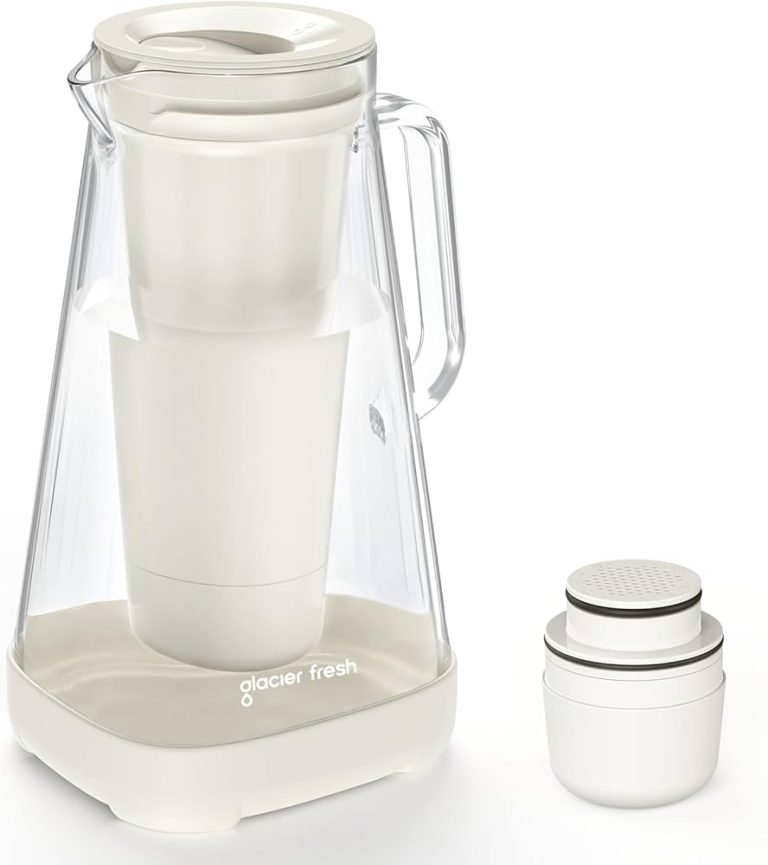When you reach for a water pitcher, have you ever paused to consider what it’s made of? The choice between glass and plastic isn’t just about aesthetics—it’s about your health, sustainability, and the taste of your water.
Imagine pouring a refreshing drink for yourself or your guests, knowing you’ve made the best choice for both your wellbeing and the planet. As you read on, you’ll discover the hidden benefits and potential drawbacks of each option, empowering you to make informed decisions in your daily life.
Are you ready to uncover which pitcher truly deserves a spot in your kitchen? Let’s dive in.

Credit: www.amazon.com
Material Composition
Choosing between glass and plastic water pitchers involves understanding their material composition. Glass offers a clean, durable option, resisting stains and odors. Plastic pitchers are lightweight, shatterproof, and often more affordable. Each material has its own benefits, influencing durability and user preference.
Choosing the right water pitcher for your home can be a real game-changer. Understanding the material composition of glass and plastic pitchers is crucial to making an informed decision. Both materials have unique properties that affect durability, safety, and environmental impact. Let’s dive into the specifics of each.Properties Of Glass
Glass water pitchers are known for their elegance and transparency. They let you see the contents clearly, which is particularly useful when you want to ensure cleanliness or admire the fruit slices in your infused water. Glass is non-porous, meaning it doesn’t absorb odors or flavors from previous contents. This ensures that every pour remains fresh and untainted. It’s also made from natural materials like sand, lime, and soda ash. These elements make glass environmentally friendly as it’s easily recyclable. Think about the long-term impact on the planet when choosing your pitcher.Properties Of Plastic
Plastic water pitchers are lightweight and shatterproof, making them ideal for outdoor use or households with children. You won’t have to worry about accidents that might lead to shattered pieces on the floor. They come in various designs and colors, offering versatility in style. Whether you prefer a sleek modern look or vibrant hues, there’s a plastic pitcher out there for you. However, be mindful of the type of plastic. BPA-free options are safer and prevent chemical leaching into your beverages. The convenience of plastic pitchers can be enticing, but consider if safety and health are worth the trade-off. How do these properties align with your lifestyle needs? Do you prioritize aesthetics, durability, or environmental sustainability? Understanding these aspects can help you choose the perfect pitcher for your daily hydration rituals.
Credit: lifestraw.com
Durability And Longevity
Choosing between glass and plastic water pitchers often boils down to durability and longevity. Both materials have their advantages and downsides. Understanding these can help you make an informed decision. Let’s explore how each performs in terms of impact resistance and wear and tear over time.
Impact Resistance
Glass pitchers offer a touch of elegance and style. They resist scratches better than plastic. But they are prone to shattering if dropped. This can be a safety concern in homes with kids. Plastic pitchers, on the other hand, are less fragile. They can survive accidental falls. This makes them more suitable for active households.
Wear And Tear Over Time
Glass pitchers maintain their clarity and shine for years. They are resistant to stains and odors. This makes them a long-lasting choice. Plastic pitchers can show signs of wear over time. They may become cloudy or retain smells. Regular exposure to heat can accelerate this process. Yet, high-quality plastic pitchers can offer decent longevity. Choose wisely based on your lifestyle and usage needs.
Safety And Health Considerations
Choosing between glass and plastic water pitchers involves safety and health factors. Glass is free of chemicals like BPA, offering peace of mind. Plastic is lighter and more durable, but may contain harmful substances. Consider the environment and your personal health priorities when making a choice.
When choosing a water pitcher, safety and health considerations should be at the forefront of your decision-making process. Both glass and plastic pitchers have unique benefits and potential drawbacks that can impact your well-being. Understanding these factors can help you make an informed choice that aligns with your health priorities and lifestyle needs. ###Chemical Leaching Concerns
Plastic water pitchers often raise concerns about chemical leaching, especially those containing BPA or other harmful compounds. When exposed to heat or sunlight, certain plastics can release chemicals into your drinking water, which might affect your health over time. Glass pitchers, on the other hand, are chemically inert and do not leach any substances, making them a safer choice for those concerned about chemical exposure. Have you ever noticed an off taste in water that’s been sitting in a plastic pitcher? This could be a sign of leaching. Opting for a glass pitcher can eliminate this worry and give you peace of mind about what’s in your water. ###Temperature Resistance
Temperature resistance is another crucial factor when evaluating glass and plastic pitchers. Glass pitchers are known for their ability to withstand a wide range of temperatures. You can pour hot liquids into them without fear of warping or releasing harmful chemicals. Plastic pitchers, however, may not handle temperature fluctuations as well. They can warp when exposed to high temperatures, potentially compromising their structural integrity and safety. Consider how you plan to use your pitcher. If you regularly enjoy iced tea or infused water, a glass pitcher might better serve your needs. Imagine hosting a summer gathering with friends, serving refreshing iced drinks in a durable, temperature-resistant glass pitcher. It’s not just about aesthetics; it’s about ensuring your drinks remain pure and safe for everyone to enjoy. In the end, the choice between glass and plastic water pitchers involves weighing these safety and health considerations. Have you thought about how your current water pitcher might impact your health? Making a switch could be a simple yet significant step towards a healthier lifestyle.Environmental Impact
Choosing between glass and plastic water pitchers affects the environment. Glass pitchers are recyclable and non-toxic. Plastic pitchers, while lightweight, contribute to pollution and take longer to decompose. Consider the long-term environmental impact of your choice.
When it comes to choosing a water pitcher, the environmental impact is a crucial consideration. Glass and plastic are the two most common materials, each with its own ecological footprint. Understanding these differences can help you make a more sustainable choice that aligns with your values.Recyclability
Glass is highly recyclable and can be processed without losing quality. It’s often recycled in a closed-loop system, meaning old glass becomes new glass. This makes it an excellent option if you’re looking to minimize waste. In contrast, plastic recycling is more complex. Not all types of plastic are recyclable, and even those that are can degrade in quality over time. This means less of it is reused, often ending up in landfills or oceans. Have you ever tried to recycle a plastic item, only to find out it wasn’t accepted? This is a common frustration that highlights the limitations of plastic recycling. Choosing glass can alleviate this issue, allowing you to contribute more effectively to recycling efforts.Carbon Footprint
The carbon footprint of glass and plastic water pitchers varies significantly. Glass production requires high temperatures, which results in more energy consumption. However, its longer lifespan can offset this initial impact. Plastic, on the other hand, is produced using fossil fuels, contributing to greenhouse gas emissions. While it’s lighter and thus requires less energy to transport, the environmental cost of its production and disposal is high. Think about the last time you purchased a plastic item. Did you consider the energy used from production to disposal? These hidden costs add up, making glass a more sustainable option in the long run. Choosing between glass and plastic isn’t just about what suits your kitchen decor. It’s a decision that impacts the planet. Would you rather support a system that prioritizes recyclability and reduces waste, or one that adds to environmental strain? Your choice can make a difference. Consider these insights next time you’re in the market for a water pitcher.Aesthetic And Design
When choosing between glass and plastic water pitchers, their aesthetic and design play a crucial role. How do these materials impact the visual appeal and the variety of styles available? Let’s dive into the nuances of each option to help you make an informed choice that suits your taste and home decor.
Visual Appeal
Glass water pitchers often exude a timeless elegance. The clear, transparent nature of glass allows you to see the contents inside, adding a touch of sophistication to your dining table. Imagine pouring a refreshing lemonade into a crystal-clear glass pitcher; the vibrant color becomes part of the aesthetic itself.
Plastic pitchers, on the other hand, can offer vibrant colors and patterns. While they may not have the classic look of glass, they can bring a playful and modern vibe to your kitchen. Have you ever noticed how a bright-colored plastic pitcher can cheer up a casual picnic? It’s all about matching the mood.
Variety Of Styles
Glass pitchers come in a range of designs, from sleek and minimalist to ornate and decorative. Some feature intricate engravings or unique shapes that make them a centerpiece on your table. Picture a pitcher with a delicate etching that complements your dinnerware—it’s not just a vessel, it’s a statement piece.
Plastic pitchers offer versatility in design that’s hard to beat. You can find them in different shapes, sizes, and colors, catering to any occasion or preference. Whether you’re hosting a kid’s birthday party or a casual brunch, there’s a style for every event. Plus, they’re often lightweight and easy to handle, adding convenience to their charm.
When choosing between glass and plastic, consider what resonates with your personal style. Do you prefer the classic elegance of glass or the bold versatility of plastic? Think about the occasions you’ll use it for and the ambiance you wish to create. Your choice can define the aesthetics of your setting, turning an ordinary moment into a memorable one.

Credit: barproducts.com
Cost And Affordability
Choosing between glass and plastic water pitchers depends on cost and affordability. Both options come with unique price points. Understanding these can guide your decision.
Initial Purchase Price
Glass pitchers usually have a higher price tag. They are often seen as a luxury item. Their elegant design can justify the extra cost. Plastic pitchers are cheaper and more budget-friendly. They are widely accessible and available in many stores.
Long-term Value
Glass pitchers offer long-term durability. They are less likely to scratch or stain. This can add to their value over time. Plastic pitchers may wear out sooner. Frequent replacements might increase costs in the long run. Glass often retains its clarity, while plastic can become cloudy.
Ease Of Maintenance
Choosing between glass and plastic water pitchers involves various factors. Ease of maintenance is one of the most important. A pitcher that is easy to clean saves time and effort. It also ensures your water stays fresh and safe to drink.
Cleaning Requirements
Glass water pitchers usually require less effort to clean. Their smooth surface lets dirt and residue wash off easily. Warm soapy water often does the trick. For stubborn stains, a simple vinegar solution can help.
Plastic pitchers need more attention. They can develop scratches over time. These can trap dirt and bacteria. Regular scrubbing might be necessary. Using a brush can help remove grime from hard-to-reach spots.
Stain And Odor Resistance
Glass pitchers resist stains better than plastic ones. The non-porous surface prevents odors from sticking. You can fill them with any beverage without worry.
Plastic pitchers might absorb odors and stains. This happens especially when used with strong-flavored drinks. Over time, these can become difficult to remove. Using baking soda can help tackle persistent smells.
Both materials have their pros and cons. Your choice depends on what matters most to you. Easy cleaning or long-lasting freshness.
Consumer Preferences
When choosing between glass and plastic water pitchers, you might wonder what others prefer. Consumer preferences often shift due to trends, reviews, and personal experiences. This section explores these preferences, helping you make a more informed decision.
Popular Trends
Glass pitchers are gaining popularity for their elegant look and eco-friendly nature. They add a touch of sophistication to any kitchen or dining table.
Plastic pitchers, however, are favored for their lightweight and durable design. They are a go-to option for outdoor events and family gatherings.
What’s trending in your circle? Are you drawn to the stylish appeal of glass or the practicality of plastic?
User Reviews
Many users rave about glass pitchers for their ability to retain the pure taste of water. They appreciate not having to worry about chemicals leaching into their drinks.
On the other hand, users often highlight the convenience of plastic pitchers. They love not having to worry about breaking them with everyday use.
Your neighbors might prefer glass for its aesthetic, while your friends might opt for plastic due to its ease of use. What’s your take on these reviews?
Consider your lifestyle and habits. Do you prioritize design over practicality, or vice versa? Understanding your own needs can guide you toward the best choice.
Frequently Asked Questions
Are Glass Water Pitchers Better Than Plastic?
Glass water pitchers are often preferred over plastic due to their durability and non-toxic nature. They don’t leach chemicals, ensuring safe drinking water. Glass retains no odors or flavors, enhancing taste. It’s eco-friendly and recyclable, making glass a sustainable choice for health-conscious consumers.
Is It Better To Drink Water Out Of Glass Or Plastic?
Glass is better for drinking water. It doesn’t contain harmful chemicals like BPA found in some plastics. Glass is eco-friendly, reusable, and preserves taste. Plastic can be convenient but may leach chemicals over time. For health and sustainability, choose glass over plastic.
Are Plastic Water Filter Pitchers Bad?
Plastic water filter pitchers aren’t inherently bad. They effectively remove impurities from water. Choose BPA-free models to avoid chemical leaching. Regularly change filters for optimal performance. Consider environmental impact, as plastic contributes to waste. Explore glass or stainless steel alternatives for eco-friendliness.
Always follow manufacturer’s guidelines for safe use.
Is It Better To Use Glass Or Plastic Bottles?
Glass bottles are eco-friendly and recyclable, reducing environmental impact. They preserve taste better than plastic. Plastic bottles are lightweight and convenient but may leach chemicals. Choose glass for sustainability and quality, plastic for convenience. Consider environmental impact and personal needs when deciding.
Conclusion
Choosing between glass and plastic pitchers isn’t easy. Glass pitchers offer elegance and durability. They keep water cool and taste pure. Plastic pitchers are lightweight and less prone to breaking. They are great for outdoor events. Consider your priorities. Do you value style or convenience?
Both options have benefits. Remember, glass can be heavier and more fragile. Plastic may not last as long. Select the pitcher that fits your lifestyle. Think about where and how you’ll use it. The perfect pitcher is out there. Make a choice that suits your needs.
Enjoy your refreshing drinks!


